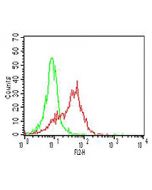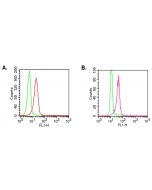Cookie Policy: This site uses cookies to improve your experience. You can find out more about our use of cookies in our Privacy Policy. By continuing to browse this site you agree to our use of cookies.
AdipoGen Life Sciences
anti-TLR2, mAb (ABM3A87) (APC)

| Product Details | |
|---|---|
| Synonyms | Toll-like Receptor 2; CD282; Toll/Interleukin-1 Receptor-like Protein 4; TIL4 |
| Product Type | Monoclonal Antibody |
| Properties | |
| Clone | ABM3A87 |
| Isotype | Mouse IgG1κ |
| Immunogen/Antigen | Recombinant human TLR2 protein (aa 180-420). |
| Label/Conjugates | APC |
| Application |
Flow Cytometry: (0.5-1μg/106 cells) |
| Crossreactivity |
Human Mouse |
| Specificity |
Recognizes human and mouse TLR2. |
| Purity | Protein G purified. |
| Concentration | 0.2mg/ml |
| Formulation | Liquid. In PBS containing 0.05% sodium azide. |
| Isotype Negative Control | |
| Shipping and Handling | |
| Shipping | BLUE ICE |
| Short Term Storage | +4°C |
| Long Term Storage | +4°C |
| Handling Advice |
Do not freeze. Protect from light. |
| Use/Stability | Stable for at least 6 months after receipt when stored at +4°C. |
| Documents | |
| MSDS |
 Download PDF Download PDF |
| Product Specification Sheet | |
| Datasheet |
 Download PDF Download PDF |
TLR2 (Toll-like Receptor 2) is a member of the TLR (Toll-like receptor) family that plays a fundamental role in pathogen recognition and activation of innate immunity. TLR2 acts via MYD88 and TRAF6, leading to NF-κB activation, cytokine secretion and the inflammatory response. TLR2 resides on the plasma membrane where it responds to lipid-containing pathogen-associated molecular patterns (PAMPs), such as lipoteichoic acid and di- and tri-acylated cysteine-containing lipopeptides. It does this by forming dimeric complexes with either TLR1 or TLR6, which consequently is the initial step in a cascade of events leading to significant innate immune responses, development of adaptive immunity to pathogens and protection from immune sequelae related to infections with these pathogens. TLR2 also interacts with a large number of non-TLR molecules such as LY96 (MD-2), allowing for recognition of a great number and variety of PAMPs (pathogen-associated molecular patterns). TLR2 expression has been detected in immune cells, endothelial and epithelial cells.










